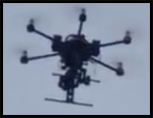Some press exposure was given recently to the news that Secom are actively looking to utilise ‘drones’ for the private security market on a rental basis. [1]
This appears to relate to the American market with the rental price given in dollars, yet is the UK market also ready to consider the possibilities?
The usage of drones, also referred to as Unmanned Aerial Vehicles (‘UAVs’), in the military sector has been known about and discussed widely for quite a while now. However, the typical lapse into commercial operations is beginning to take place quite quickly now and with the addition of Chinese CCTV market into the mix along with a thriving amateur hobbyist community (thankfully both non-weaponised for now) we are now able to consider the application of this technology in a serious manner in relation to the UK electronic security industry. [2]
Scope
Drones generally come many forms, it seems though that two main types are established at the moment in the commercial and civilian markets – ‘Multicopter’ types which are devices with several rotors designed to assist in direct and immediate flight and the more traditional aircraft types similar to model planes.
Drones are defined as “an aircraft without a human pilot on board. Its flight is either controlled autonomously by computers in the vehicle, or under the remote control of a pilot on the ground or in another vehicle”
This also leaves open the possibility of a drone definition as an unmanned aircraft under the control of a pilot in a remote location.
ARCs & UAVs – A good match?
There are some restrictions in the utilisation of drones in the UK. The Civil Aviation Authority (CAA) states that drones can be flown without a pilot's licence as long as they meet the following criteria:
- They must weigh less than 20 kilograms
- Remain below a height of 122 metres
- Remain within visual line of sight of the pilot
- Remain within 500m of the pilot
- Only be flown away from populated areas and airports
- Pilots must also be able to take over manual control if required
- Permission must be sought from the CAA [3] [4]
This would seem to prevent the deployment of drones by remote centres but how would this affect an Alarm Receiving Centre ('ARC') with trained and licensed pilots with drones utilised under regulatory control for protection of a building?
What about site based rooftop drones, which have a single application following an activation of flying directly upwards, transmitting footage from an aerial viewpoint before descending to recharge again?
Protection in the event of a fire or duress situation could be more effectively managed perhaps with aerial thermal imaging and CCTV.
Would manual PTZ control of such devices and utilisation of 4G for transmission purposes open up a new avenue for protection of property?
Would we, in this scenario, eventually be petitioned by the police to take things a step further and follow suspects away from the property whilst they are en route so as to assist in a successful arrest?
The use of two way audio in combination with a flyover by a drone device could be a powerful tool to deter would be burglars from a property. With a carefully managed marketing exercise to demonstrate effective results (similar to the smartwater approach) we could as an industry add another difficult to overcome layer of protection causing less well prepared miscreants to be caught and/or identified more effectively.
Considerations
There are some caveats to consider of course as with any new technology.
Weather restrictions – wind shear, storms affecting flight
Fog and other visibility issues restricting vision – much as with tradtional CCTV
Recharging the UAV – Contact based charging solutions are now viable however
Communications – The usage of robust 4G and 5G solutions should resolve this
Auditing – On board encrypted SD cards should assist here
Security of control – An important issue which I will describe below in more depth
Health & Safety – Any such vehicle could potentially cause an accident or harm if lost
Privacy – As always privacy concerns would have to be addressed and respected [5] [6]
On the issue of security of control I would like to point out that where control of a Drone is intercepted by a third party we must be able prove that such action has taken place.
There ought to be mandatory requirements regarding the security of access in line with current standards relating to all other security equipment in use. Though the application may be different the same level of care ought to be considered.
This leaves us with some more questions to ask and discuss with regards the impact on and usage of UAVs within our sector:
- Would you consider implementing this technology?
- Do our current standards suitably allow for this technology to be utilised?
- Is it appropriate for ARCs to implement licensed pilots for this purpose?
- Would installers consider implementing these devices in specific installations?
- Does an aerial viewpoint offer advantages over properly sited CCTV?
- Should individual ARCs be licensed to pilot security UAVs?
- Would a single RVRC specialising in remotely controlled UAVs be a better approach than many RVRCs/ARCs offering individual solutions?
As always, please feel free to discuss, sharing your thoughts and views on this subject…
References:
[1] – Engadget.com – Secom offers a private security drone (December 2012)
[2] – Wired.co.uk – Here come the drones… (July 2012)
[3] – Civil Aviation Authority – Policy for Light UAV Systems (May 2004)
[4] – Civil Aviation Authority – CAP722 Guidance (August 2012)
[5] – Global Research – Civil liberties and the CAA (December 2011)
[6] – Youtube – BBC coverage of increased drone usage (Decembe 2012)



3 Comments
Recommended Comments